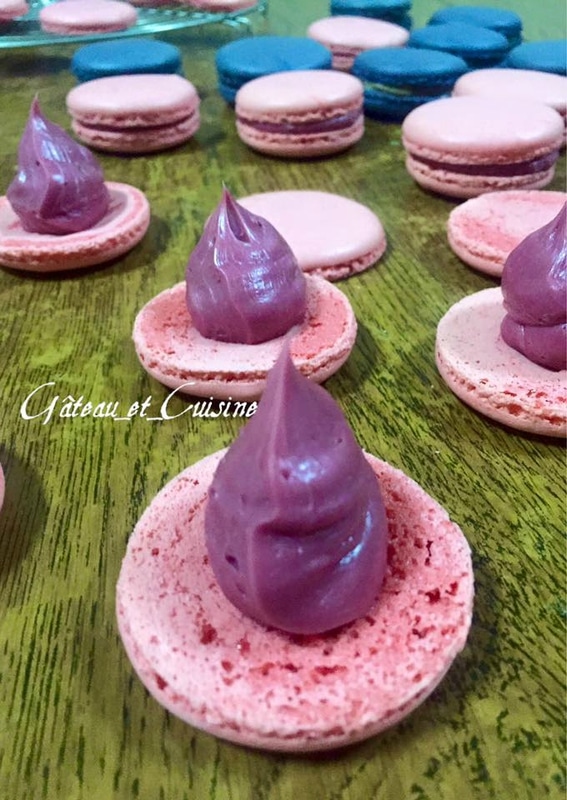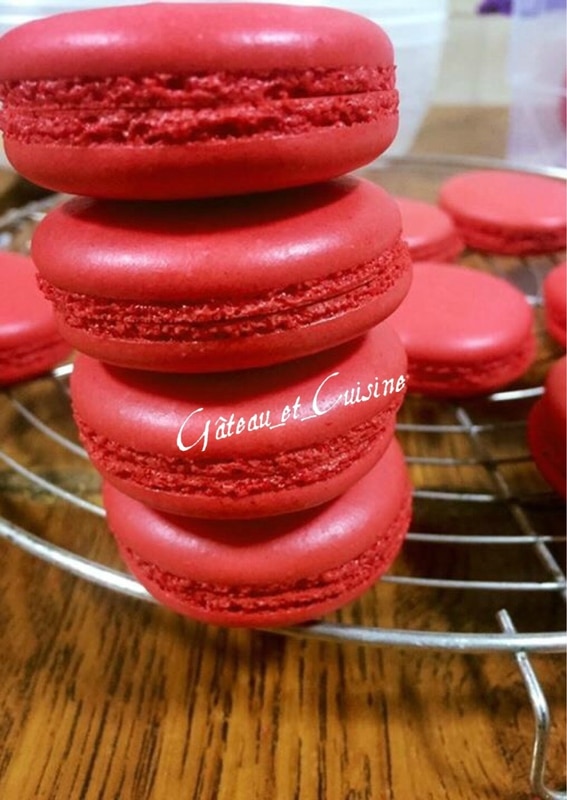
If you’re new to making macarons, the simplest and most beginner-friendly method is the French meringue macaron recipe. It’s a great way to get familiar with macaronage and learn how to bake them properly.
I’m sharing two versions of the recipe that give the same result, you can choose the one that works best for you depending on how you prefer to measure ingredients.
This method is easier and quicker than the Italian meringue macarons, which requires a thermometer. It’s perfect for practicing piping without needing a special macaron mat or drawn templates. After just a few tries, you’ll be able to create beautiful macarons while refining your technique and baking skills.
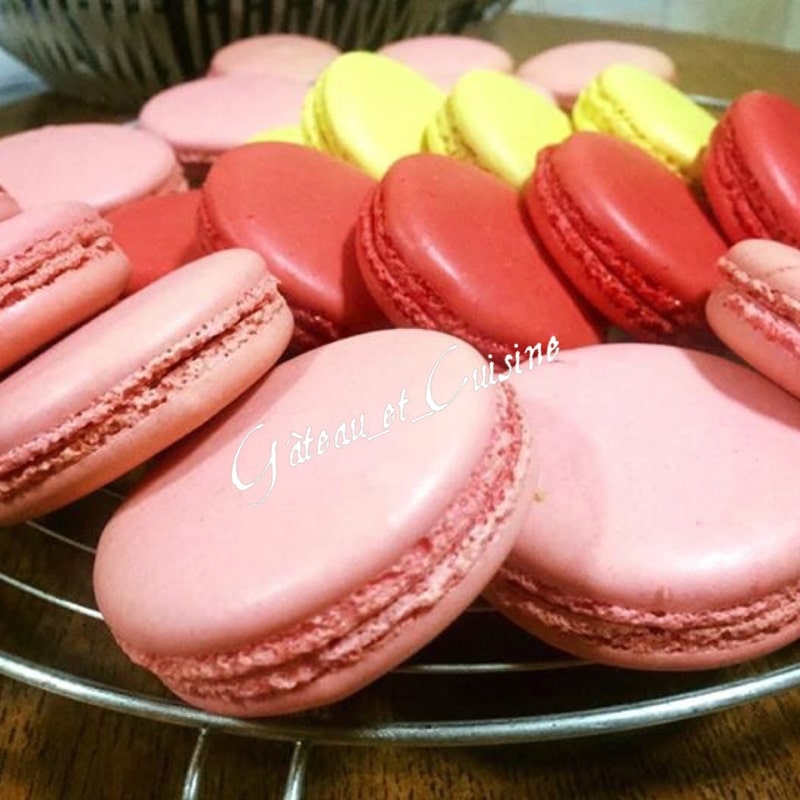
Table of Contents
Tips for successful French meringue macarons
To prepare the “tant pour tant” (a mixture of equal parts almond flour and powdered sugar):
If you have very fine almond flour, you can simply mix it with the powdered sugar without the need to sift.
Otherwise, it’s best to use slightly more than the indicated quantities of almond flour and powdered sugar (about 10 to 15% extra of each), mix them together, then sift.
This helps avoid losing too much weight after sifting compared to what’s required in the recipe.
Once sifted, weigh the amount needed for your recipe:
- 150 g of tant pour tant for the first recipe
- 250 g for the second recipe
Your egg whites should be at room temperature on the day of preparation.
Ideally, separate them 2 to 3 days in advance and store them in an airtight container in the fridge. Take them out the day before so they’re ready to whip properly.
To make the meringue, you can use a stand mixer like a KitchenAid, or simply a hand mixer.
You don’t need any fancy equipment, a bowl, a spatula, and a piping bag are more than enough to get started!
Once the macarons are piped, let them rest for 20 to 40 minutes, or longer if the ambient humidity is high. The surface should be dry to the touch and no longer sticky.
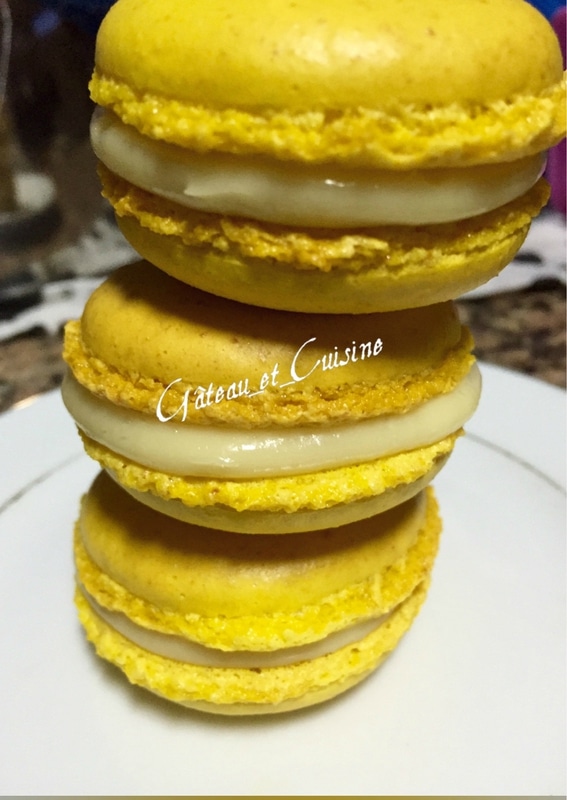
Ingredients:
NB: You’ll find the printable recipe card at the end of the article.
1st Recipe (Small Batch – Yields About 20 to 25 Shells)
- 56 g egg whites (at room temperature, preferably aged)
- 75 g granulated sugar
- 75 g almond flour (if the almond flour is not very fine and you need to blend it with the powdered sugar, add 10 to 15% more of each to avoid weight loss of the “tant pour tant” mixture, equal parts almond flour and powdered sugar, during sifting).
- 75 g powdered sugar
- Water-soluble food coloring (powder or gel – avoid liquid)
2nd Recipe (Larger Batch – Yields About 40 to 50 Shells)
- 90 g egg whites (at room temperature, ideally aged)
- 125 g granulated sugar
- 125 g almond flour (if the almond flour is not very fine and you need to blend it with the powdered sugar, add 10 to 15% more of each to avoid weight loss of the “tant pour tant” mixture, equal parts almond flour and powdered sugar, during sifting).
- 125 g powdered sugar
- Water-soluble food coloring (powder or gel – avoid liquid)
Ganache (Enough for About 20 Filled Macarons)
- 150 g white chocolate (preferably chips or finely chopped)
- 75 ml heavy cream
- 8 g honey
- 10 g butter
- Flavoring of your choice (colored flavorings work great for a fun visual touch!)
Preparation steps :
Blend the almond flour and powdered sugar without heating the mixture. Sift the resulting “tant pour tant” onto a sheet of parchment paper or into a bowl, then weigh the amount needed for the recipe.
Beat the egg whites on low speed in the bowl of the stand mixer fitted with the whisk attachment. As soon as they start to foam, add half of the sugar.
Continue beating until stiff peaks form, then add the remaining sugar. Beat further until you achieve a firm, shiny meringue with a bird’s beak (the meringue forms a curved point at the end of the whisk).
Add the powder or gel food coloring towards the end, then mix until the meringue is smooth and uniform. Keep in mind to make the color slightly darker, as it will tend to lighten during baking.
Pour the almond flour and powdered sugar mixture (tant pour tant) over the meringue. Using a spatula, perform the J-fold technique by folding from the bottom up while turning the bowl, to fully combine the dry ingredients with the meringue without deflating the mixture.
Macaronage: Work the batter by pressing it against the sides of the bowl, then gathering it back to the center. Repeat until the mixture becomes smooth, glossy, and flows in ribbons from the spatula, not too runny, but not stiff either.
Note: You can replace the whisk with the paddle attachment (K) of the mixer and use it for macaronnage. Run the mixer on low speed for 10 seconds, then check the texture. It’s better to stop just before reaching the final texture, which should flow in a ribbon, and finish with a spatula to avoid ending up with a mixture that’s too runny.
Fill a piping bag fitted with a #8 tip, then pipe the macarons into 2 to 3 cm rounds on a baking sheet lined with parchment paper or a silicone mat (like Silpat) with markings. You can also use a template placed under the parchment paper to help guide you, but it’s not essential.
Gently tap the underside of the baking sheet or drop it lightly onto the countertop to smooth the shells and release any air bubbles.
Let them rest for 20 to 40 minutes, depending on the humidity level: the surface of the shells should be dry to the touch and no longer stick to your finger.
Baking
Preheat the oven to 150°C (300°F), with a convection setting if possible.
Bake for 12 to 14 minutes, depending on your oven.
About 5 to 6 minutes into baking, the feet (the characteristic frilly base) should start to appear.
After about 7 minutes, slightly open the oven door for a few seconds to release the steam, this helps prevent the shells from cracking.
By the end of baking, the shells should be firm and should not move or wiggle when you gently touch the surface or the base.
Remove the tray from the oven, slide off the parchment paper, and let the macarons cool completely before removing them.

Prepare the Ganache for Filling:
Melt the white chocolate gently over a double boiler.
Meanwhile, heat the cream and honey in a small saucepan. Once it begins to simmer, remove it from the heat.
Off the heat, gradually incorporate the hot cream into the melted chocolate in three additions, mixing well after each to emulsify (the texture should become smooth and homogeneous).
Next, add the butter and your desired flavoring. Mix well, then use an immersion blender to perfect the emulsion and achieve a smooth ganache.
Pour the ganache into a piping bag, and let it rest at room temperature for 2 to 3 hours, allowing it to firm up for piping.
Fill half of the macaron shells with the ganache, then pair them up to assemble.
For the best results, refrigerate the macarons for 24 hours before enjoying: this allows the ganache to infuse into the shells, adding extra softness.
How to store macarons?
You can store them for up to a week in the refrigerator, in an airtight container. Remember to take them out 15 to 20 minutes before serving so they regain their full softness.
To store them for a longer period or to plan ahead for a big event, they freeze very well.
You can freeze the shells alone or the fully assembled macarons. Simply place them flat in a container or on a tray, well-protected.
Before serving, let them defrost gently in the refrigerator, then bring them to room temperature.
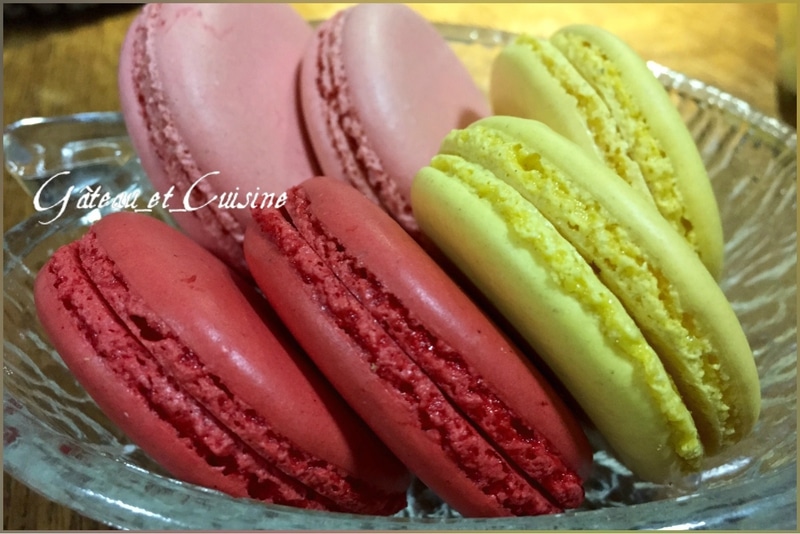
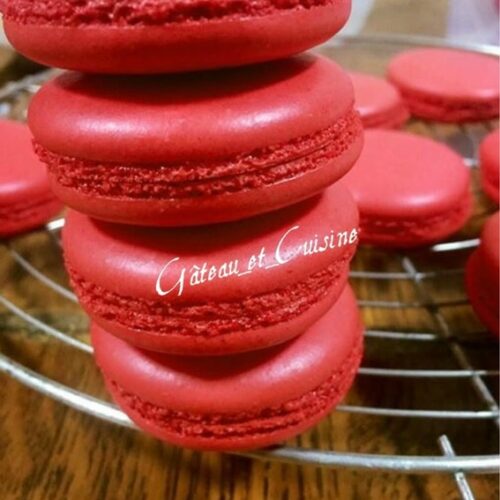
Basic French Meringue Macarons Recipe
EQUIPEMENTS
INGREDIENTS
1st Recipe (Small Batch - Yields About 20 to 25 Shells)
- 56 g egg whites at room temperature, preferably aged
- 75 g granulated sugar
- 75 g almond flour if the almond flour is not very fine and you need to blend it with the powdered sugar, add 10 to 15% more of each to avoid weight loss of the "tant pour tant" mixture, equal parts almond flour and powdered sugar, during sifting.
- 75 g powdered sugar
- Water-soluble food coloring powder or gel - avoid liquid
2nd Recipe (Larger Batch - Yields About 40 to 50 Shells)
- 90 g egg whites at room temperature, ideally aged
- 125 g granulated sugar
- 125 g almond flour if the almond flour is not very fine and you need to blend it with the powdered sugar, add 10 to 15% more of each to avoid weight loss of the "tant pour tant" mixture, equal parts almond flour and powdered sugar, during sifting.
- 125 g powdered sugar
- Water-soluble food coloring powder or gel - avoid liquid
Ganache (Enough for About 20 Filled Macarons)
- 150 g white chocolate preferably chips or finely chopped
- 75 ml heavy cream
- 8 g honey
- 10 g butter
- Flavoring of your choice colored flavorings work great for a fun visual touch!
PREPARATION
Prepare the macaron shells
- Blend the almond flour and powdered sugar without heating the mixture. Sift the resulting "tant pour tant" onto a sheet of parchment paper or into a bowl, then weigh the amount needed for the recipe.
- Beat the egg whites on low speed in the bowl of the stand mixer fitted with the whisk attachment. As soon as they start to foam, add half of the sugar.
- Continue beating until stiff peaks form, then add the remaining sugar. Beat further until you achieve a firm, shiny meringue with a bird's beak (the meringue forms a curved point at the end of the whisk).
- Add the powder or gel food coloring towards the end, then mix until the meringue is smooth and uniform. Keep in mind to make the color slightly darker, as it will tend to lighten during baking.
- Pour the almond flour and powdered sugar mixture (tant pour tant) over the meringue. Using a spatula, perform the J-fold technique by folding from the bottom up while turning the bowl, to fully combine the dry ingredients with the meringue without deflating the mixture.
- Macaronage: Work the batter by pressing it against the sides of the bowl, then gathering it back to the center. Repeat until the mixture becomes smooth, glossy, and flows in ribbons from the spatula, not too runny, but not stiff either.
- Note: You can replace the whisk with the paddle attachment (K) of the mixer and use it for macaronnage. Run the mixer on low speed for 10 seconds, then check the texture. It's better to stop just before reaching the final texture, which should flow in a ribbon, and finish with a spatula to avoid ending up with a mixture that's too runny.
- Fill a piping bag fitted with a #8 tip, then pipe the macarons into 2 to 3 cm rounds on a baking sheet lined with parchment paper or a silicone mat (like Silpat) with markings. You can also use a template placed under the parchment paper to help guide you, but it's not essential.
- Gently tap the underside of the baking sheet or drop it lightly onto the countertop to smooth the shells and release any air bubbles.
- Let them rest for 20 to 40 minutes, depending on the humidity level: the surface of the shells should be dry to the touch and no longer stick to your finger.
Baking
- Preheat the oven to 150°C (300°F), with a convection setting if possible.
- Bake for 12 to 14 minutes, depending on your oven.
- About 5 to 6 minutes into baking, the feet (the characteristic frilly base) should start to appear.
- After about 7 minutes, slightly open the oven door for a few seconds to release the steam, this helps prevent the shells from cracking.
- By the end of baking, the shells should be firm and should not move or wiggle when you gently touch the surface or the base.
- Remove the tray from the oven, slide off the parchment paper, and let the macarons cool completely before removing them.
Prepare the Ganache for Filling:
- Melt the white chocolate gently over a double boiler.
- Meanwhile, heat the cream and honey in a small saucepan. Once it begins to simmer, remove it from the heat.
- Off the heat, gradually incorporate the hot cream into the melted chocolate in three additions, mixing well after each to emulsify (the texture should become smooth and homogeneous).
- Next, add the butter and your desired flavoring. Mix well, then use an immersion blender to perfect the emulsion and achieve a smooth ganache.
- Pour the ganache into a piping bag, and let it rest at room temperature for 2 to 3 hours, allowing it to firm up for piping.
- Fill half of the macaron shells with the ganache, then pair them up to assemble.
- For the best results, refrigerate the macarons for 24 hours before enjoying: this allows the ganache to infuse into the shells, adding extra softness.
Thank you for your visit and your comments!

